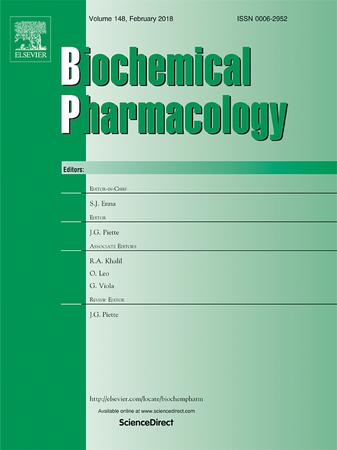The LDL Receptor-Related Protein 1: Mechanisms and roles in promoting Aβ efflux transporter in Alzheimer’s disease
IF 5.3
2区 医学
Q1 PHARMACOLOGY & PHARMACY
引用次数: 0
Abstract
The LDL Receptor-Related Protein 1(LRP1), a member of the Low-density Lipoprotein (LDL) receptor family, is a multifunctional cellular transporter and signaling receptor, this includes regulation of lipid metabolism, cell migration and signaling. Abnormal accumulation of amyloid beta (Aβ) in the brain is thought to be the main pathological change in Alzheimer’s disease. By binding to a variety of ligands, LRP1 is involved in the internalization and degradation of Aβ, thereby affecting the course of Alzheimer’s disease (AD). Here, we discuss the main mechanisms by which LRP1 mediates Aβ degradation and clearance and several current therapeutic approaches targeting LRP1. Finally, we concluded that modulating the expression level of LRP1 is an effective way to attenuate Aβ deposition and ameliorate AD.
Abbreviations: LRP1, LDL Receptor-Related Protein 1;LDL, Low Density Lipoprotein; Aβ, amyloid beta; AD, Alzheimer’s disease; APP, amyloid precursor protein; ApoE, apolipoprotein E; TGF, growth factor; MMP, matrix metalloproteinase;TAT, thrombin-antithrombin complex; BBB, blood–brain barrier; MMP-9,cyclophilin A (CypA)-matrix metalloproteinase-9; VMC, Vascular Mural Cell; IDE,insulin degrading enzyme; EVs, extracellular vesicles; sLRP1,shed LRP1; BDNF, brain-derived neurotrophin; IGF-1,insulin-like growth factor 1; NGF, nerve growth factor; MAPK,mitogen-activated protein kinase; ERK1/2,exogenous signal-regulated kinase1/2;JNK, c-Jun amino-terminal kinase; TLR4, toll-like receptor 4; NF-κB,nuclear factor-κB; GCAP,guanylate cyclase-activating protein; KD, ketogenic diet;KB, ketone body; BLECs,Brain-like endothelial cell; BYHWD, Buyang Huanwu decoction; LGZG, Linguizhugan decoction;P- gp, P-glycoprotein;PPARγ, Peroxisome proliferator-activated receptor γ;SP16,SERPIN peptide 16; Asx, Astaxanthin; Bex, Bexarotene;

低密度脂蛋白受体相关蛋白 1:在阿尔茨海默病中促进 Aβ 外流转运体的机制和作用。
低密度脂蛋白受体相关蛋白1(LRP1)是低密度脂蛋白(LDL)受体家族的成员,是一种多功能细胞转运体和信号受体,包括调控脂质代谢、细胞迁移和信号转导。淀粉样 beta(Aβ)在大脑中的异常积累被认为是阿尔茨海默病的主要病理变化。通过与多种配体结合,LRP1 参与了 Aβ 的内化和降解,从而影响了阿尔茨海默病(AD)的病程。在此,我们讨论了 LRP1 介导 Aβ 降解和清除的主要机制,以及目前针对 LRP1 的几种治疗方法。最后,我们得出结论:调节 LRP1 的表达水平是减轻 Aβ 沉积和改善 AD 的有效方法。缩写:LRP1,低密度脂蛋白受体相关蛋白1;LDL,低密度脂蛋白;Aβ,淀粉样β蛋白;AD,阿尔茨海默病;APP,淀粉样前体蛋白;ApoE,载脂蛋白E;TGF,生长因子;MMP,基质金属蛋白酶;TAT,凝血酶-抗凝血酶复合物;BBB,血脑屏障;MMP-9,环嗜蛋白 A(CypA)-基质金属蛋白酶-9;VMC,血管壁细胞;IDE,胰岛素降解酶;EVs,细胞外囊泡;sLRP1,脱落的 LRP1;BDNF,脑源性神经营养素;IGF-1,胰岛素样生长因子 1;NGF,神经生长因子;MAPK,丝裂原活化蛋白激酶;ERK1/2,外源信号调节激酶 1/2;JNK,c-Jun 氨基末端激酶;TLR4,类收费受体 4;NF-κB,核因子-κB;GCAP,鸟苷酸环化酶激活蛋白;KD,生酮饮食;KB,酮体;BLECs,类脑血管内皮细胞;BYHWD,步阳黄乌煎;LGZG,林桂珠甘煎;P- gp,P-糖蛋白;PPARγ,过氧化物酶体增殖激活受体γ;SP16,SERPIN 肽 16;Asx,虾青素;Bex,贝沙罗汀。
本文章由计算机程序翻译,如有差异,请以英文原文为准。
求助全文
约1分钟内获得全文
求助全文
来源期刊

Biochemical pharmacology
医学-药学
CiteScore
10.30
自引率
1.70%
发文量
420
审稿时长
17 days
期刊介绍:
Biochemical Pharmacology publishes original research findings, Commentaries and review articles related to the elucidation of cellular and tissue function(s) at the biochemical and molecular levels, the modification of cellular phenotype(s) by genetic, transcriptional/translational or drug/compound-induced modifications, as well as the pharmacodynamics and pharmacokinetics of xenobiotics and drugs, the latter including both small molecules and biologics.
The journal''s target audience includes scientists engaged in the identification and study of the mechanisms of action of xenobiotics, biologics and drugs and in the drug discovery and development process.
All areas of cellular biology and cellular, tissue/organ and whole animal pharmacology fall within the scope of the journal. Drug classes covered include anti-infectives, anti-inflammatory agents, chemotherapeutics, cardiovascular, endocrinological, immunological, metabolic, neurological and psychiatric drugs, as well as research on drug metabolism and kinetics. While medicinal chemistry is a topic of complimentary interest, manuscripts in this area must contain sufficient biological data to characterize pharmacologically the compounds reported. Submissions describing work focused predominately on chemical synthesis and molecular modeling will not be considered for review.
While particular emphasis is placed on reporting the results of molecular and biochemical studies, research involving the use of tissue and animal models of human pathophysiology and toxicology is of interest to the extent that it helps define drug mechanisms of action, safety and efficacy.
 求助内容:
求助内容: 应助结果提醒方式:
应助结果提醒方式:


